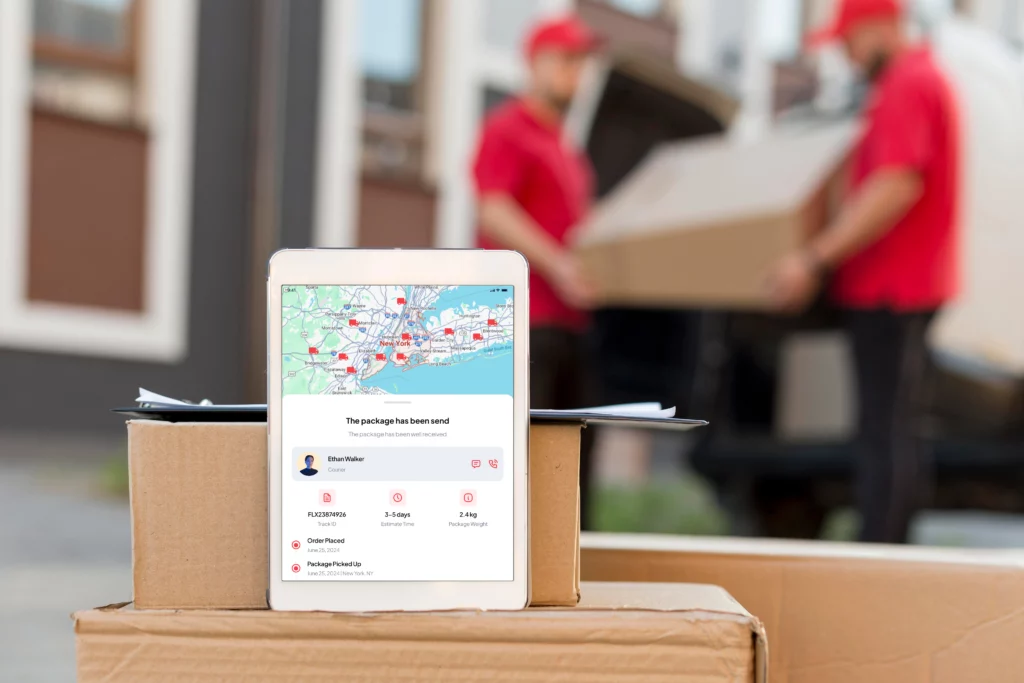Introduction
As the world embraces the gig economy and the demand for quick, efficient deliveries grows, independent couriers are playing a more significant role in the logistics sector. These couriers need a simple yet powerful app that helps them navigate their tasks, manage deliveries, and stay connected with customers. Developing a delivery app for independent couriers is a game-changer—it enhances the operational efficiency of couriers while also giving businesses a tool to streamline logistics.
In this guide, we’ll explore how to build a delivery app tailored for independent couriers, focusing on the key features, trends, and expert advice that can set your app apart from the competition.
Why Independent Couriers Need a Custom Delivery App
Unlike large-scale logistics companies, independent couriers operate on a much smaller scale, often managing multiple deliveries without the support of a central system. A dedicated mobile app can empower these couriers to manage their delivery schedules, optimize routes, track earnings, and communicate efficiently with clients—all in one place.
Here are a few key reasons why an app is essential for independent couriers:
- Operational Efficiency: Apps streamline scheduling, route planning, and delivery tracking, saving time and reducing human error.
- Enhanced Customer Experience: Real-time updates, live tracking, and seamless communication between couriers and customers improve the overall experience.
- Increased Earning Potential: With optimized routes and better delivery management, couriers can complete more jobs in less time, increasing their daily earning potential.
- Data Management: Apps offer couriers insights into their deliveries, helping them track their performance, earnings, and customer satisfaction.
Key Trends in Delivery App Development for Couriers
Before jumping into the development process, it’s crucial to understand the key trends shaping the logistics industry and courier apps. Staying on top of these trends will help you design an app that aligns with both current needs and future expectations.
1. Real-Time GPS Tracking
Consumers increasingly demand transparency when it comes to deliveries. Real-time GPS tracking allows customers to monitor the status and location of their delivery in real time, offering them peace of mind and boosting satisfaction. For couriers, GPS tracking makes it easy to monitor their route and provides accurate ETAs for deliveries.
Key Features to Include:
- Real-time GPS tracking for couriers and customers
- Delivery status updates with automatic notifications
- Route tracking for completed deliveries
2. Route Optimization
Couriers often waste time and fuel taking inefficient routes. With route optimization powered by AI, couriers can automatically find the most efficient path for their deliveries. This saves time, reduces fuel costs, and maximizes the number of deliveries that can be completed in a day.
Key Features to Include:
- AI-driven route planning and optimization
- Traffic condition updates
- Multi-stop route planning for batch deliveries
3. On-Demand Services
Many independent couriers work with multiple companies or individuals who require flexible, on-demand delivery services. Whether they’re delivering food, packages, or documents, your app needs to accommodate on-demand requests and match couriers to jobs in real-time.
Key Features to Include:
- Instant job matching for available couriers
- Real-time job notifications and requests
- Scheduling for future deliveries
4. Contactless Delivery Options
The demand for contactless delivery grew significantly during the COVID-19 pandemic, and it remains a preferred option for many consumers. Implementing a contactless delivery feature in your app allows couriers to deliver items without physical interaction, while providing confirmation through photos or digital signatures.
Key Features to Include:
- Contactless delivery option with photo confirmation
- Digital signatures for proof of delivery
- In-app delivery instructions for customers
5. In-App Payment Systems
Independent couriers often handle payments directly, making a secure, in-app payment system a must-have feature. This system should allow customers to pay via credit card, digital wallets, or even cryptocurrency, ensuring smooth, secure transactions.
Key Features to Include:
- Secure payment gateways (credit card, PayPal, Apple Pay, etc.)
- Automated payment receipts
- Tracking of earnings and payment history for couriers
6. Customer Reviews and Ratings
Couriers, especially those operating independently, rely heavily on their reputation. Incorporating a customer review and rating system into your app allows customers to provide feedback on their delivery experience, helping couriers build trust and improve their services.
Key Features to Include:
- Customer review and rating system
- Courier profile with past performance and ratings
- Ability for couriers to leave feedback for customers
Must-Have Features for a Courier Delivery App

Now that you’re aware of the trends shaping the industry, let’s dive into the specific features that your delivery app should have to ensure smooth operations for both couriers and customers.
1. Easy Onboarding and Profile Management
Independent couriers come from various backgrounds, so the onboarding process should be simple, guiding users step-by-step through registration, verification, and profile setup. Profiles should include essential information such as availability, payment details, and delivery preferences.
Features to Include:
- Quick sign-up with ID verification
- Profile setup with availability, contact info, and preferred service area
- Payment method integration for quick payouts
2. Delivery Job Assignment and Scheduling
The core of any courier app is the ability to assign and manage delivery jobs. Couriers should be able to accept or decline jobs, view job details, and schedule deliveries easily.
Features to Include:
- Real-time job assignment notifications
- Detailed job descriptions (pickup, drop-off location, items, etc.)
- Scheduling for future deliveries and reminders
3. Live Delivery Tracking for Customers
Providing customers with live tracking of their deliveries is essential for transparency and customer satisfaction. They should be able to view the courier’s location and receive real-time updates on their delivery status.
Features to Include:
- Map view of courier location
- Real-time status updates (picked up, en route, delivered)
- Estimated delivery time with automatic updates
4. Courier Dashboard for Job Management
Couriers need a clear overview of their day-to-day jobs, including completed and upcoming deliveries. A dashboard feature should provide couriers with detailed information about their deliveries, earnings, and job performance.
Features to Include:
- Delivery history with completion times and earnings
- Upcoming deliveries with detailed instructions
- Performance tracking with earnings breakdown
5. Notifications and Alerts
Both couriers and customers need real-time notifications to stay informed. Couriers should receive alerts about new delivery jobs, while customers should be notified when their delivery is on its way or completed.
Features to Include:
- Job acceptance and completion notifications for couriers
- Delivery status updates for customers
- Alerts for changes in delivery timing or instructions
6. Support and Assistance
Issues such as delivery problems, customer complaints, or technical glitches can arise at any time. An in-app support system should be available for both couriers and customers to resolve issues quickly.
Features to Include:
- In-app customer support chat
- FAQ section for common questions
- Reporting system for delivery issues or customer disputes

Pro Tips for Developing a Successful Delivery App
Creating a successful courier app goes beyond just implementing the right features. Here are some expert tips to ensure your app thrives in the competitive logistics industry:
1. Start Small and Scale Gradually
Rather than trying to build a complex app with every feature possible, start with an MVP (Minimum Viable Product) that includes the core features—like job assignments, route optimization, and payment systems. As you gather feedback from couriers and customers, you can gradually scale and add more features based on their needs.
2. Focus on User Experience (UX)
An intuitive user interface (UI) and smooth user experience (UX) are crucial for the success of your app. Couriers need to navigate the app quickly while on the go, and customers expect a hassle-free experience when tracking their deliveries or communicating with the courier.
3. Implement Scalability from the Start
Your app should be built with scalability in mind, allowing it to grow as your courier network and customer base expand. Partnering with an experienced mobile app development agency or a custom web application development company can ensure that your app’s infrastructure can handle increased demand over time.
4. Offer Multi-Platform Support
To ensure the widest reach possible, your app should be available on both iOS and Android platforms. This will give couriers the flexibility to use the app regardless of the device they have, and you’ll capture more customers across different platforms.
5. Data-Driven Enhancements
Use the data collected from your app to make informed decisions about future updates and features. Analyzing user behavior, delivery patterns, and feedback will help you understand what couriers and customers need, allowing you to continuously improve the app’s performance.
Conclusion
A custom delivery app for independent couriers can streamline the logistics process, improve courier efficiency, and provide a seamless customer experience. By integrating must-have features such as real-time tracking, route optimization, and secure payments, your app can stand out in the competitive delivery market.
